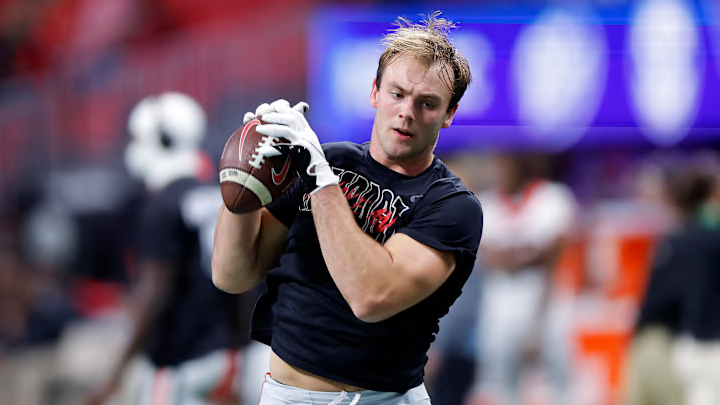You should not want your favorite team to spend a top 10 pick on a tight end in the draft, no matter how good you think the player is. Recent history has proven that the success rate of hitting on a tight end at the top end of the draft is extremely rare. And even if your team does find a good tight end by using a top pick, they are not making a wise financial decision. Let's look deeper:
Almost every year we hear that "this tight end is different" and worthy of being a high pick. Well, over the last decade, almost every tight end taken in the first round hasn't been worth the selection, regardless of how highly they were touted coming out as prospects.
1st round tight ends rookie outcomes since 2011 pic.twitter.com/CzzMlGAaCh
— Jason_OTC (@Jason_OTC) February 26, 2024
Kyle Pitts was called a "generational tight end prospect" by some of the most respected draft analysts out there. While it's too early to call him a bust, he hasn't lived up to being the 4th overall selection in the 2021 draft. TJ Hockenson and Eric Ebron were both disappointing for the Lions and weren't worth being selected in the top 10 of their respective drafts. Even going back to O.J Howard in the 2017 class, he was also considered a "generational" prospect. He never turned into the all-pro player that everyone expected. What this really shows us is that the tight end position is one of the hardest positions to evaluate.
The temptation to secure a dynamic tight end prospect like Brock Bowers, who is currently projected as a top-10 pick in the 2024 NFL Draft, is undeniable. His athleticism, elite run-after-the-catch ability, and huge production can be an easy sell that he is the missing piece to an elite offense. This article isn't about Brock Bowers the player; it's about the position he plays. Here are the main reasons not to take one early:
Cost Factor
Drafting a tight end in the top 10 comes with a hefty price tag. As NFL Network's Daniel Jeremiah pointed out recently on the "Move the Sticks" podcast, using a high pick means paying them a rookie contract comparable to the league's top tight ends. Essentially, you're not saving money at the position. So why spend the high draft capital on one when you could just use that money to pay a veteran free-agent tight end who is already proven and draft another position?
Finding Gems Later in the Draft
The good news for NFL teams is that drafting a tight end in the later rounds has yielded far greater success stories. Players like Travis Kelce (3rd round), George Kittle (5th round), and Darren Waller (6th round) have all become offensive superstars, showing the value of patience while waiting to take one. You can still find elite tight end talent throughout the draft, not just concentrated in the top 10. This allows teams to prioritize other crucial positions early on, knowing they can still address the tight end position later without sacrificing valuable resources.
It is very similar to how running backs are treated by the NFL. It is very easy to find a running back on day three that can come in and be a day-one starter compared to other positions. Tight ends seem to be following the same trend in recent years.
Development Curve
Tight ends often require a longer development period compared to other positions. Their complex role demands learning blocking schemes, route running, and receiving skills, often taking several years to fully blossom. Unlike a pass rusher who can immediately put pressure on the quarterback or a cornerback who can shut down a receiver from day one, a high-drafted tight end might not contribute significantly early in their career. The delayed return on investment potential is one more reason not to spend a high pick on a tight end.
Positional Value
Investing a top-10 pick on a tight end limits resources available for addressing other crucial positions like offensive line, edge rusher, or cornerback. Players at these positions often have a higher chance of immediate and long-term impact compared to tight ends. Yes, if you have a Travis Kelce or a George Kittle, they have tremendous value. But an above-average tight end is nowhere near as valuable as an above-average tackle, edge rusher or cornerback.
Brock Bowers' Case
While Bowers is a talented prospect and one of the better prospects in recent memory, history suggests caution. He might require time to adjust to the NFL's demands, and drafting him in the top 10 comes with inherent risks. But, he is rare after the catch and was used in a unique role with Georgia. He was often used on reverses and handoffs, which only a team with an outlier at tight end would do. While undersized, he has fantastic speed and the ability to stretch the middle of a defense. He has great hands and was very productive at his time with the Bulldogs.
Brock Bowers thread: #Bulldogs
— Dustin Mosher (@Dustin_Mosher) August 9, 2023
Bowers is one of the best tight ends at creating yards after the catch in recent memory pic.twitter.com/01LvY9ATxG
Investing in other positions with a higher success rate for immediate impact offers a more sustainable and successful approach to building a championship-caliber team, and you shouldn't want your favorite team to draft one early.
